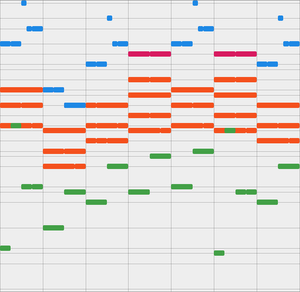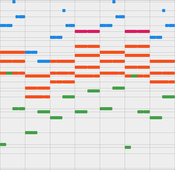Information
- Publication Type: Conference Paper
- Workgroup(s)/Project(s):
- Date: August 2021
- ISBN: 978-1-4503-8613-5/21/08
- Publisher: ACM Press
- Open Access: no
- Location: Virtual
- Lecturer: Lukas Eibensteiner
- Address: New York, NY, USA
- Event: ACM SIGPLAN International Workshop on Functional Art, Music, Modelling, and Design
- DOI: 10.1145/3471872.3472971
- Call for Papers: Call for Paper
- Booktitle: Proceedings of the 9th ACM SIGPLAN International Workshop on Functional Art, Music, Modelling, and Design (FARM ’21)
- Pages: 12
- Conference date: 27. August 2021
- Pages: 23 – 34
- Keywords: algorithmic composition, music, domain specific language
Abstract
We present temporal-scope grammars for automatic composition of polyphonic music. In the context of this work, polyphony can refer to any arrangement of musical entities (notes, chords, measures, etc.) that is not purely sequential in the time dimension. Given that the natural output of a grammar is a sequence, the generation of sequential structures, such as melodies, harmonic progressions, and rhythmic patterns, follows intuitively. By contrast, we associate each musical entity with an independent temporal scope, allowing the representation of arbitrary note arrangements on every level of the grammar. With overlapping entities we can model chords, drum patterns, and parallel voices – polyphony on small and large scales. We further propose the propagation of sub-grammar results through the derivation tree for synchronizing independently generated voices. For example, we can synchronize the notes of a melody and bass line by reading from a shared harmonic progression.
Additional Files and Images
Additional images and videos
Additional files
Weblinks
BibTeX
@inproceedings{eibens-2021-tsgpmg,
title = "Temporal-Scope Grammars for Polyphonic Music Generation",
author = "Lukas Eibensteiner and Martin Il\v{c}\'{i}k and Michael
Wimmer",
year = "2021",
abstract = "We present temporal-scope grammars for automatic composition
of polyphonic music. In the context of this work, polyphony
can refer to any arrangement of musical entities (notes,
chords, measures, etc.) that is not purely sequential in the
time dimension. Given that the natural output of a grammar
is a sequence, the generation of sequential structures, such
as melodies, harmonic progressions, and rhythmic patterns,
follows intuitively. By contrast, we associate each musical
entity with an independent temporal scope, allowing the
representation of arbitrary note arrangements on every level
of the grammar. With overlapping entities we can model
chords, drum patterns, and parallel voices – polyphony on
small and large scales. We further propose the propagation
of sub-grammar results through the derivation tree for
synchronizing independently generated voices. For example,
we can synchronize the notes of a melody and bass line by
reading from a shared harmonic progression.",
month = aug,
isbn = "978-1-4503-8613-5/21/08",
publisher = "ACM Press",
location = "Virtual",
address = "New York, NY, USA",
event = "ACM SIGPLAN International Workshop on Functional Art, Music,
Modelling, and Design",
doi = "10.1145/3471872.3472971",
booktitle = "Proceedings of the 9th ACM SIGPLAN International Workshop on
Functional Art, Music, Modelling, and Design (FARM ’21)",
pages = "12",
pages = "23--34",
keywords = "algorithmic composition, music, domain specific language",
URL = "https://www.cg.tuwien.ac.at/research/publications/2021/eibens-2021-tsgpmg/",
}


 preprint
preprint
